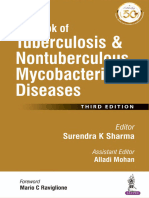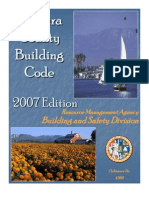Bula Ca PDF
Bula Ca PDF
Uploaded by
Fadhli Muhammad KurniaCopyright:
Available Formats
Bula Ca PDF
Bula Ca PDF
Uploaded by
Fadhli Muhammad KurniaOriginal Title
Copyright
Available Formats
Share this document
Did you find this document useful?
Is this content inappropriate?
Copyright:
Available Formats
Bula Ca PDF
Bula Ca PDF
Uploaded by
Fadhli Muhammad KurniaCopyright:
Available Formats
Occult lung cancer in patients with bullous emphysema
In conclusion, these data show that, although
there is no gender difference in the prevalence
of asthma, women have a considerably higher
risk than men of being admitted to hospital for
the disease. This raises the possibility of genderrelated differences in the severity of asthma or,
perhaps, in the management of the disease,
including admission thresholds.
The following are members of The Copenhagen City Heart
Study Group: G Jensen, P Schnohr, M Appleyard, J Nyboe, M
Grenbk, B Nordestgaard, P Lange. This study was supported
by The National Union against Lung Diseases, The Danish
Heart Foundation, and The Danish Medical Research Council
(1216611).
289
1 Skobeloff EM, Spivey WH, Clair SS, Schoffstall JM. The
influence of age and sex on asthma admissions. JAMA
1992;268:343740.
2 Hyndman SJ, Williams DR, Merrill SL, Lipscombe JM,
Palmer CR. Rates of admission to hospital for asthma (see
comments). BMJ 1994;308:1596600.
3 Morris RD, Munasinghe RL. Geographic variability in hospital admission rates for respiratory disease among the
elderly in the United States. Chest 1994;106:117281.
4 Lange P, Nyboe J, Appleyard M, Jensen G, Schnohr P.
Ventilatory function and chronic mucus hypersecretion as
predictors of death from lung cancer. Am Rev Respir Dis
1990;141:6137.
5 Enarson DA, Vedal S, Schulzer M, Dybuncio A, Chan-Yeung
M. Asthma, asthmalike symptoms, chronic bronchitis, and
the degree of bronchial hyperresponsiveness in epidemiologic surveys. Am Rev Respir Dis 1987;136:6137.
6 Markowe HL, Bulpitt CJ, Shipley MJ, Rose G, Crombie DL,
Fleming DM. Prognosis in adult asthma: a national study.
BMJ 1987;295:94952.
Thorax 1997;52:289290
Occult lung cancer in patients with bullous
emphysema
Federico Venuta, Erino A Rendina, Edoardo O Pescarmona, Tiziano De Giacomo,
Dario Vizza, Isac Flaishman, Costante Ricci
Department of
Thoracic Surgery
F Venuta
E A Rendina
T De Giacomo
D Vizza
I Flaishman
C Ricci
Department of
Experimental
Medicine and
Pathology
E O Pescarmona
University di Roma
La Sapienza,
Policlinico Umberto I,
Viale del Policlinico,
00100 Rome, Italy
Correspondence to:
Dr F Venuta.
Received 2 February 1996
Returned to authors
23 April 1996
Revised version received
10 July 1996
Accepted for publication
25 September 1996
Abstract
Background The incidence of lung cancer is increased in patients with bullous
emphysema.
Methods A series of 95 patients undergoing excision of bullous lung tissue was
reviewed to determine the incidence and
long term outcome of occult carcinoma
present in the resected material.
Results Four patients (4.2%) had peripheral foci of large cell carcinoma in the
resection specimen (three bullectomies
and one lobectomy).
Conclusions Resected bullous lung tissue
should be carefully examined for areas of
bronchogenic carcinoma. The results of
incidental complete excision are favourable.
(Thorax 1997;52:289290)
Keywords: bullous emphysema, lung cancer.
Early diagnosis and complete resection are considered key factors in achieving long term survival in non-small cell lung cancer. The
incidence of this malignancy is reported to
be 32 times higher in patients with bullous
emphysema.13 These patients may, however,
also require surgery for excision of bullous air
spaces because of functional impairment or
other complications. Since scar carcinoma has
been reported,46 we routinely perform complete gross and histological examination of the
wall of the resected bulla, with multiple samples
of scars, areas of increased thickness, and
grossly normal bulla wall.
We report our experience with four patients
who underwent surgery for giant bullous em-
physema with an incidental finding of microscopic occult lung cancer localised in a
macroscopically normal section of the wall of
the bulla.
Methods
From 1979 to 1993 95 patients with bullous
emphysema of the lung underwent surgical
bullectomy. Four (4.2%) of these patients (aged
40, 44, 48, and 51 years) were found on routine
histological examination of the resected material to have occult carcinoma and are the
subject of this retrospective study. Normal
phenotypes for a1-antitrypsin were found.
Chest radiography and computed tomographic
(CT) scanning were diagnostic for giant bullous
disease with enlarged air spaces accounting for
at least 50% of the involved hemithorax. No
increased pleural thickness, lung nodules, or
other solid lesions were evident at preoperative
evaluation. Pulmonary function tests showed a
mean forced expiratory volume in one second
(FEV1) of 1.32 l, a mean functional residual
capacity (FRC) of 5.51 l, and a mean Pa2 of
9.0 kPa; the mean MVV was 32% of predicted.
Pulmonary perfusion and ventilation scans
were consistent with the presence of poorly
ventilated unperfused air spaces. Angiography
revealed that the pulmonary vessels of the residual lung were dislocated and compressed by
the bulla with no sign of anomalous vascular
proliferation. Fibreoptic bronchoscopy did not
show any endobronchial lesion. Three bullectomies and one lobectomy were performed
through a standard posterolateral thoracotomy
as these cases predated the advent of videoassisted thoracoscopy. The pathologist sampled
290
Venuta, Rendina, Pescarmona, De Giacomo, Vizza, Flaishman, et al
every area of increased thickness or scar either
at the base or on the wall of the bulla, in
addition to random multiple sampling of several apparently normal areas. After the histological diagnosis of cancer was obtained the
four patients were staged with total body CT
scanning and a bone scan.
Results
No postoperative complications were observed.
Postoperative pulmonary function tests showed
increased values with a mean FEV1 of 1.81 l,
a mean FRC of 4.2 l, a mean MVV of 66% of
predicted; mean Pa2 increased to 11.09 kPa.
Macroscopically, the surface of the bullae was
smooth in all cases without any pleural retraction and no sign of suspicious lesions. All
scars and areas of increased thickness of the
wall were histologically classified as fibrosis.
Microscopic foci of lung carcinoma were obtained in areas without any significant macroscopic alteration or scars. The lesions were
composed of large atypical cells with prominent
nucleoli and abundant clear cytoplasm.
Postoperative staging did not show the presence of lymph node involvement or distant
metastases and the patients were classified as
T1N0M0. The patients are alive and free of
disease after 10, eight, seven, and five years,
respectively.
Discussion
The increased incidence of lung cancer in
patients with bullous emphysema may pose
several problems regarding the timing and strategy of surgery. There are many reports in the
literature regarding radiologically evident bronchogenic carcinoma presenting simultaneously
with bullae or years after their surgical resection,13 710 but we have found no other report
concerning the detection of occult lung cancer
associated with giant bullous emphysema. The
presence of scars, the smoking habit of the
patients, and air trapping within the bulla may
contribute to the development of cancer if the
enlarged air space is not removed.46 Accurate
preoperative imaging is necessary to detect any
dubious area on the wall of the bulla or in
the residual lung. Nevertheless, microscopic
lesions can be detected only at pathological
examination and even frozen sections may not
be of help. In fact, in all our cases the foci of
neoplastic cells were detected by chance on
random biopsy specimens of macroscopically
normal areas of the wall of the bulla. The
lesions were some distance from the scars and
thus we did not classify them as scar carcinoma.
Any lung mass associated with bullae should
be considered an indication for surgery. On the
other hand, patients with giant bullous disease
detected radiologically, without evidence of
parenchymal lesions, require different considerations. These patients undergo surgery on
the basis of the dimensions of the bulla, the
degree of functional impairment, and the presence of complications.
For these reasons, a bulla should be completely excised rather than plicated or folded
at its base to reinforce the suture line as has been
proposed by others.11 Similarly, the Monaldi
procedure and its modifications12 should be
considered only in patients unfit for surgery.
In all our patients the tumour was far away
from the stapler line and thus the resection
could be considered complete.
On the basis of our limited experience we
believe that the incidence of occult lung cancer
in this subset of patients may be underestimated. Surgical resection of emphysematous bullae should be as complete as possible
and accurate histological examination of all
resected material should be undertaken.
1 Stoloff IL, Kanofsky P, Magliner L. The risk of lung cancer
in males with bullous disease of the lung. Arch Environ
Health 1971;22:1637.
2 Scannell JG. Bleb carcinoma of the lung. J Thorac Cardiovasc Surg 1980;80:9048.
3 Goldstein MJ, Snider GL, Liberson M, Poske RM. Bronchogenic carcinoma and giant bullous disease. Am Rev
Respir Dis 1968;97:106270.
4 Yokoo H, Suckow EE. Peripheral lung cancers arising in
scars. Cancer 1961;14:120515.
5 Raeburn C, Spencer H. Lung scar cancers. Br J Tuberc
1957;51:23745.
6 Freant LJ, Joseph WL, Adkins PC. Scar carcinoma of the
lung, fact or fantasy. Ann Thorac Surg 1974;17:5317.
7 Johnson KT. Severe bullous emphysema and contralateral
bronchogenic carcinoma: successful management with
staged bilateral thoracotomy. Wis Med J 1985;84:1114.
8 Nickoladze GD. Bullae and lung cancer. J Thorac Cardiovasc
Surg 1993;105:186.
9 Guerin JC, Martinat Y, Boniface E, Champel F. Distrophie
bulleuse et cancers bronchopulmonaires chez des sujets
jeunes. Rev Pneumol Clin 1986;42:215.
10 Aronberg DJ, Sagel SS, Le Frank S, Kuhn C, Susman N.
Lung carcinoma associated with bullous lung disease in
young men. AJR 1980;134:24952.
11 Deslauriers J, Leblanc P. Bullous and bleb diseases of the
lung. In: Shields TW, ed. General thoracic surgery. 4th
edn. Malvern, Pennsylvania: Williams and Wilkins, 1994:
90729.
12 Shah SS, Goldstraw P. Surgical treatment of bullous emphysema: experience with the Brompton technique. Ann
Thorac Surg 1994;58:14526.
You might also like
- K Surendra Sharma - Alladi Mohan - Textbook of Tuberculosis and Nontuberculousis Mycobacterial Diseases-Jaypee Medical Publishers (2019)No ratings yetK Surendra Sharma - Alladi Mohan - Textbook of Tuberculosis and Nontuberculousis Mycobacterial Diseases-Jaypee Medical Publishers (2019)1,002 pages
- Pulmonary Nodules and Masses After Lung and Heart-Lung TransplantationNo ratings yetPulmonary Nodules and Masses After Lung and Heart-Lung Transplantation7 pages
- Emphysema Versus Chronic Bronchitis in COPD: Clinical and Radiologic CharacteristicsNo ratings yetEmphysema Versus Chronic Bronchitis in COPD: Clinical and Radiologic Characteristics8 pages
- Maiwand Asimakopoulos 2004 Cryosurgery For Lung Cancer Clinical Results and Technical AspectsNo ratings yetMaiwand Asimakopoulos 2004 Cryosurgery For Lung Cancer Clinical Results and Technical Aspects8 pages
- Depiction Control: ECG Prognostic Significance of ECG Changes in Acute PneumoniaNo ratings yetDepiction Control: ECG Prognostic Significance of ECG Changes in Acute Pneumonia5 pages
- An Unusual Presentation of Multiple Cavitated Lung Metastases From Colon CarcinomaNo ratings yetAn Unusual Presentation of Multiple Cavitated Lung Metastases From Colon Carcinoma4 pages
- Chest Radiographic Findings in Primary Pulmonary Tuberculosis: Observations From High School OutbreaksNo ratings yetChest Radiographic Findings in Primary Pulmonary Tuberculosis: Observations From High School Outbreaks6 pages
- Hutchinson 2019 - Spectrum of Lung Adenocarcinoma PDFNo ratings yetHutchinson 2019 - Spectrum of Lung Adenocarcinoma PDF33 pages
- Solitary Fibrous Tumor of The Pleura: A Rare Cause of Pleural MassNo ratings yetSolitary Fibrous Tumor of The Pleura: A Rare Cause of Pleural Mass4 pages
- Bedside Lung Ultrasound in The Assessment of Alveolar-Interstitial SyndromeNo ratings yetBedside Lung Ultrasound in The Assessment of Alveolar-Interstitial Syndrome8 pages
- Internal Medicine Department Dr. M. Djamil Hospital, Padang 2017No ratings yetInternal Medicine Department Dr. M. Djamil Hospital, Padang 201721 pages
- Use Only: A Young Man With A Large Lung MassNo ratings yetUse Only: A Young Man With A Large Lung Mass3 pages
- Organizing Pneumonia: Chest HRCT Findings : Pneumonia em Organização: Achados Da TCAR de TóraxNo ratings yetOrganizing Pneumonia: Chest HRCT Findings : Pneumonia em Organização: Achados Da TCAR de Tórax7 pages
- III. The Radiology of Chronic Bronchitis: P. Lesley BidstrupNo ratings yetIII. The Radiology of Chronic Bronchitis: P. Lesley Bidstrup14 pages
- Bonnie Vorasubin, MD Arthur Wu, MD Chi Lai, MD Elliot Abemayor, MD, PHDNo ratings yetBonnie Vorasubin, MD Arthur Wu, MD Chi Lai, MD Elliot Abemayor, MD, PHD1 page
- Current Treatment of Mesothelioma TCNA 2016No ratings yetCurrent Treatment of Mesothelioma TCNA 201617 pages
- Clinical Experience of The Treatment of Solitary PNo ratings yetClinical Experience of The Treatment of Solitary P4 pages
- (1992) Yang, Pan-Chyr Luh, Kwen-Tay Chang, Dun-Bing Yu, Chong-Jen K - Ultrasonographic Evaluation of Pulmonary ConsolidationNo ratings yet(1992) Yang, Pan-Chyr Luh, Kwen-Tay Chang, Dun-Bing Yu, Chong-Jen K - Ultrasonographic Evaluation of Pulmonary Consolidation6 pages
- Sonographic Diagnosis of Pneumonia and BronchopneumoniaNo ratings yetSonographic Diagnosis of Pneumonia and Bronchopneumonia8 pages
- Contralateral Regional Recurrence After Elective Unilateral Neck Irradiation in Oropharyngeal Carcinoma-A Literature-based Critical ReviewNo ratings yetContralateral Regional Recurrence After Elective Unilateral Neck Irradiation in Oropharyngeal Carcinoma-A Literature-based Critical Review27 pages
- 06 Pathological Characteristics of FiberopticNo ratings yet06 Pathological Characteristics of Fiberoptic7 pages
- Pneumothorax: Classification and EtiologyNo ratings yetPneumothorax: Classification and Etiology17 pages
- Linical Eat Res Pri Ar L NG Cancer Presenting As P L Nar Cnsliatin Iicingpne NiaNo ratings yetLinical Eat Res Pri Ar L NG Cancer Presenting As P L Nar Cnsliatin Iicingpne Nia5 pages
- Diagnosis and Staging of Lung Carcinoma With CT Scan and Its Histopathological CorrelationNo ratings yetDiagnosis and Staging of Lung Carcinoma With CT Scan and Its Histopathological Correlation7 pages
- Clinicopathological Significance of Peritumoral Alveolar Macrophages in Patients With Resected Early-Stage Lung Squamous Cell CarcinomaNo ratings yetClinicopathological Significance of Peritumoral Alveolar Macrophages in Patients With Resected Early-Stage Lung Squamous Cell Carcinoma19 pages
- Pulmonary Synovial Sarcoma With Polypoid Endobronchial Growth: A Case Report, Immunohistochemical and Cytogenetic StudyNo ratings yetPulmonary Synovial Sarcoma With Polypoid Endobronchial Growth: A Case Report, Immunohistochemical and Cytogenetic Study5 pages
- Fluid Complications: Malignant Pleural EffusionNo ratings yetFluid Complications: Malignant Pleural Effusion11 pages
- Surgical Therapy For Necrotizing Pneumonia and Lung Gangrene PDFNo ratings yetSurgical Therapy For Necrotizing Pneumonia and Lung Gangrene PDF6 pages
- Thoracic Endoscopy: Advances in Interventional PulmonologyFrom EverandThoracic Endoscopy: Advances in Interventional PulmonologyMichael J. SimoffNo ratings yet
- Ventilating Vitality: The Role of Respiratory Medicine: The Art of Breathing: Secrets from the Oxygen HighwayFrom EverandVentilating Vitality: The Role of Respiratory Medicine: The Art of Breathing: Secrets from the Oxygen HighwayNo ratings yet
- Insecurity: A Threat To Human Existence and Economic Development in NigeriaNo ratings yetInsecurity: A Threat To Human Existence and Economic Development in Nigeria7 pages
- Healthcare Management & Social DevelopmentNo ratings yetHealthcare Management & Social Development16 pages
- Anxiety Disorders and Related Problems - Recommended READINGS 2011 - Antony - Ryerson Uni Dept Psychology100% (1)Anxiety Disorders and Related Problems - Recommended READINGS 2011 - Antony - Ryerson Uni Dept Psychology16 pages
- Operative Vaginal Delivery: Ralphe Robert C. CajucomNo ratings yetOperative Vaginal Delivery: Ralphe Robert C. Cajucom41 pages
- An Introduction To Object Relations 1997 Chap 3No ratings yetAn Introduction To Object Relations 1997 Chap 313 pages
- Family Based Treatment and Emotionally Focussed Family TherapyNo ratings yetFamily Based Treatment and Emotionally Focussed Family Therapy8 pages
- Welcome To The Cub Scout Academics and Sports Program100% (1)Welcome To The Cub Scout Academics and Sports Program147 pages
- List of Ayurvedic Manufacturing Units of West BengalNo ratings yetList of Ayurvedic Manufacturing Units of West Bengal7 pages
- CLINIC Newsletter - November-December 2010 - Final RevisionNo ratings yetCLINIC Newsletter - November-December 2010 - Final Revision4 pages

























































































